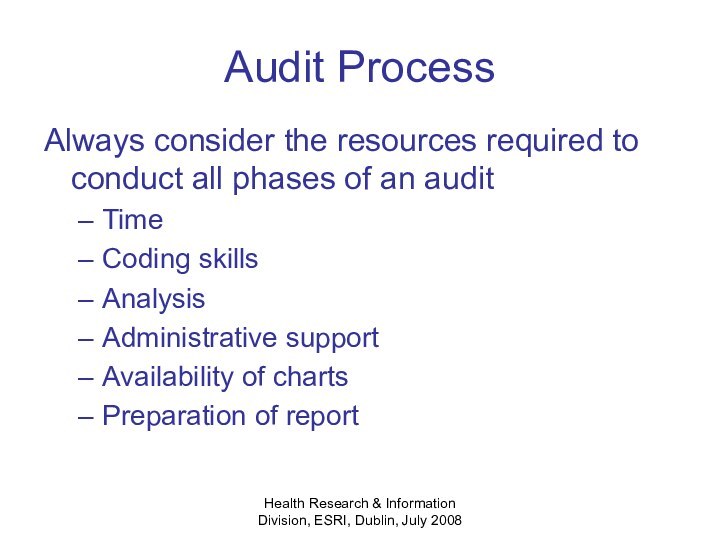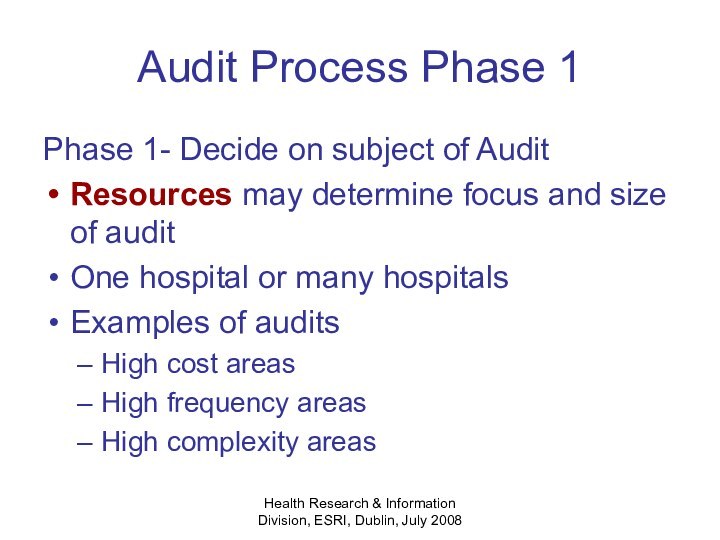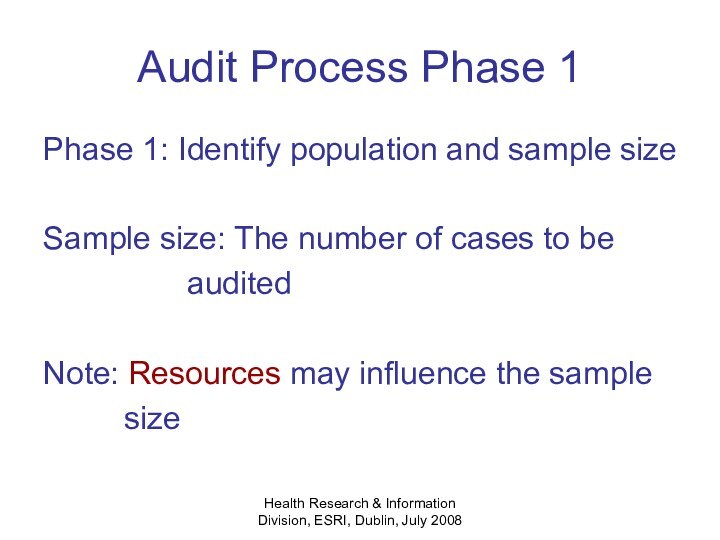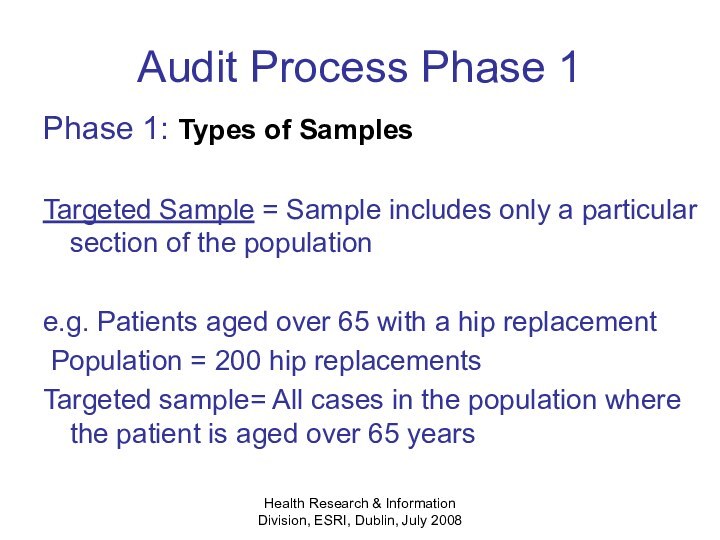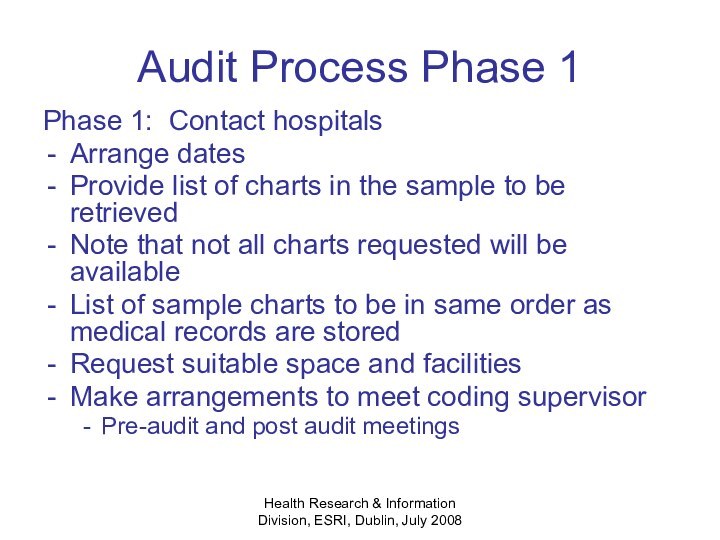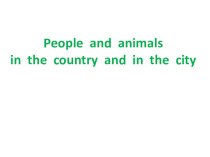Слайд 2
Health Research & Information Division, ESRI, Dublin, July
2008
The Audit Process
Phase 1: Audit Preparation
Phase 2: Conduct audit and
analyse results
Phase 3: Findings and Recommendations
The Audit report
Computerised audit
Слайд 3
Health Research & Information Division, ESRI, Dublin, July
2008
Audit Process
Always consider the resources required to conduct all
phases of an audit
Time
Coding skills
Analysis
Administrative support
Availability of charts
Preparation of report
Слайд 4
Health Research & Information Division, ESRI, Dublin, July
2008
Audit Process
Phase 1- Audit Preparation
Decide on subject of Audit
Identify
Population
Identify Sample Size
Contact Hospitals
Chart availability
Office requirements
Arrange to meet with coding staff/supervisor
Слайд 5
Health Research & Information Division, ESRI, Dublin, July
2008
Audit Process
Audit
Process
Слайд 6
Health Research & Information Division, ESRI, Dublin, July
2008
Audit Process Phase 1
Phase 1- Decide on subject of
Audit
Resources may determine focus and size of audit
One hospital or many hospitals
Examples of audits
High cost areas
High frequency areas
High complexity areas
Слайд 7
Health Research & Information Division, ESRI, Dublin, July
2008
Audit Process Phase 1
Phase 1- Decide on subject of
Audit Examples
Particular DRG
Cases with a long length of stay
Cases with a particular procedure
E.g. Hip replacements
Complex neonate cases
Cases with a stay in intensive care
Areas where there is a data quality query
Слайд 8
Health Research & Information Division, ESRI, Dublin, July
2008
Audit Process Phase1
Phase 1: Identify population and sample size
Population=
The entire number of cases that meet the chosen criteria
for the subject of the audit
When the population is known the sample size can be determined
Слайд 9
Health Research & Information Division, ESRI, Dublin, July
2008
Audit Process Phase 1
Phase 1: Identify population and sample
size
Sample size: The number of cases to be
audited
Note: Resources may influence the sample
size
Слайд 10
Health Research & Information Division, ESRI, Dublin, July
2008
Audit Process Phase 1
Phase 1: Identify population and sample
size
Sample Size: Must be practical
5% of one months discharges is a statistically acceptable sample size for a chart based audit (Source Australian Coding Benchmark Audit, 2nd Edition, NCCH, Sydney)
Слайд 11
Health Research & Information Division, ESRI, Dublin, July
2008
Audit Process Phase 1
Phase 1: Identify population and sample
size
Suggested Sample Size:
General Audit = Minimum of 40 charts
Targeted audits = Audits on specific topics can have a smaller sample size
Слайд 12
Health Research & Information Division, ESRI, Dublin, July
2008
Audit Process Phase 1
Phase 1:Types of Samples
Random Sample =
each record in the population has an equal chance of being selected for inclusion in the sample
e.g. Population = 200 hip replacements
10% random sample= any 20 cases in the population
Слайд 13
Health Research & Information Division, ESRI, Dublin, July
2008
Audit Process Phase 1
Phase 1: Types of Samples
Stratified Random
Sample = Identifying a subset of the population and randomly sampling that subset.
e.g. Patients aged over 65 with a hip replacement
Population = 200 hip replacements
10% random stratified sample= any 20 cases in the population where the patient is aged over 65 years
Слайд 14
Health Research & Information Division, ESRI, Dublin, July
2008
Audit Process Phase 1
Phase 1: Types of Samples
Targeted Sample
= Sample includes only a particular section of the population
e.g. Patients aged over 65 with a hip replacement
Population = 200 hip replacements
Targeted sample= All cases in the population where the patient is aged over 65 years
Слайд 15
Health Research & Information Division, ESRI, Dublin, July
2008
Audit Process Phase 1
Phase 1: Contact hospitals
Arrange dates
Provide list
of charts in the sample to be retrieved
Note that not all charts requested will be available
List of sample charts to be in same order as medical records are stored
Request suitable space and facilities
Make arrangements to meet coding supervisor
Pre-audit and post audit meetings
Слайд 16
Health Research & Information Division, ESRI, Dublin, July
2008
Audit Process Phase 2
Phase 2:
Reabstraction
Grouping
Comparing codes
Слайд 17
Health Research & Information Division, ESRI, Dublin, July
2008
Audit Process Phase 2
Phase 2: Reabstraction
Will original codes be
visible to auditor?
Will there be a audit data collection sheet?
Will additional information be collected?
e.g.
Presence of discharge summary
Documentation issues
Слайд 18
Health Research & Information Division, ESRI, Dublin, July
2008
Audit Process Phase 2
Phase 2: Reabstraction
Adherence to guidelines
Assessment
of completeness of chart
Meet with coding staff –
Opportunity for discussion of code differences
Preliminary findiongs and outline of next stage in process
Identify local issues that may affect coding
Слайд 19
Health Research & Information Division, ESRI, Dublin, July
2008
Audit Process Phase 2
Phase 2: Grouping
If DRG analysis is
required then recoded cases must be grouped into DRGs
Access to grouper and sytem for regrouping to allow for comparison at DRG and MDC level
Слайд 20
Health Research & Information Division, ESRI, Dublin, July
2008
Audit Process Phase 2
Phase 2: Comparing Codes
Compare original codes
to re abstracted codes
Compare original administrative data to re-abstracted data
Compare DRG assignment between original codes and re-abstracted codes.
Слайд 21
Health Research & Information Division, ESRI, Dublin, July
2008
Audit Process Phase 2
Phase 2: Comparing Codes
Diagnoses: Identify Differences
e.g.
Differences in Principal Dx
Differences in Additional Dx
Compare Average number of Dx
Differences in Sequencing of codes
Diagnoses frequency
Procedures
Слайд 22
Health Research & Information Division, ESRI, Dublin, July
2008
Audit Process Phase 2
Phase 2: Comparing Codes
Identify differences in
administrative data
Date of birth
Admission & Discharge dates
Admission code
Discharge code
Слайд 23
Health Research & Information Division, ESRI, Dublin, July
2008
Audit Process Phase 2
Phase 2: Comparing Codes
Facility to record
why codes are different.
Helps to identify factors affecting coding quality
e.g. Original coding PDx= Abdominal Pain
Re abstracted PDx= Appendicitis
Reason for difference: Original coder recorded symptom as Principal diagnosis and appendicitis as additional code
Слайд 24
Health Research & Information Division, ESRI, Dublin, July
2008
Audit Process Phase 2
Phase 2: Comparing Codes
Factors affecting coding
quality can include:
Documentation
Discharge summaries
Information on ventilation
Information on ICU stay
Coder training levels
Knowledge of coding guidelines
Correct use of Classification
Support for coding function
How will these factors be recorded?
Слайд 25
Health Research & Information Division, ESRI, Dublin, July
2008
Audit Process Phase 2
Phase 2: Comparing Codes
Identify how many
differences in each data field
And the reason for the difference
Слайд 26
Health Research & Information Division, ESRI, Dublin, July
2008
Audit Process Phase 2
Phase 2: Compare DRG assignment
Identify differences
in DRG assignment
DRG frequency
Change in severity of DRG
Identify differences in MDC assignment
Слайд 27
Health Research & Information Division, ESRI, Dublin, July
2008
Audit Process Phase 3
Phase 3: Findings & Recommendations
Having compared
data make findings and recommendations based on evidence found by the audit process
E.g. 70% of cases record a different Principal diagnoses due to poor documentation.
Слайд 28
Health Research & Information Division, ESRI, Dublin, July
2008
Audit Process Phase 3
Phase 3: Findings & Recommendations
Highlight any
areas with major differences
Highlight system problems found to affect data quality
Draw conclusions based on findings
Слайд 29
Health Research & Information Division, ESRI, Dublin, July
2008
Audit Process Phase 3
Phase 3: Findings & Recommendations
Make recommendations
that address the problems identified
Recommendations may involve areas other then the coding department
Слайд 30
Health Research & Information Division, ESRI, Dublin, July
2008
The Audit Report
Consider a standard format/house style for reports
Will
the same format be used for in-house reports?
How will data be presented
Consider confidentiality- use of a reference number instead of medical record number
Use appendices for listing detailed information – e.g. details of all cases in the sample
Слайд 31
Health Research & Information Division, ESRI, Dublin, July
2008
The Audit Report
Suggested Format
Introduction
Methodology
Audit Findings e.g.
Diagnoses
Administrative
DRG
Conclusions
Recommendations
Appendices
Слайд 32
Health Research & Information Division, ESRI, Dublin, July
2008
The Audit Report
Issue the report
Keep a record of
all audit documents and work to allow for queries by the hospital
Enclose a covering letter arranging for follow up discussions
Arrange any follow up promised by the report e.g. training
Слайд 33
Health Research & Information Division, ESRI, Dublin, July
2008
National Audit
Maintain a library of audits
Similar issues can arise
in different hospitals
Where inappropriate coding is identified – how will cases be rectified.
Number of national audits
Type of national audits
Maintain audit skills – hospital and national
Слайд 34
Health Research & Information Division, ESRI, Dublin, July
2008
Computerised Audit
Speeds up processes such as
Identifying Population
Creation of sample
Data
entry and re-grouping
Collection of reasons for code differences
Error categories
Analysis of results
Helps to maintain records of audits and outcomes to build a body of knowledge
Слайд 35
Health Research & Information Division, ESRI, Dublin, July
2008
Computerised Audit
Consider
Compatibility with hospital systems
User friendly
Creation of varied reports
Ease
of updating software if changes made to coding system
Ownership of software
Access to software


